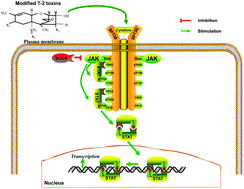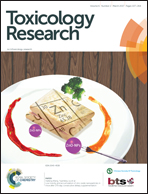Cytotoxicity of T-2 and modified T-2 toxins: induction of JAK/STAT pathway in RAW264.7 cells by hepatopancreas and muscle extracts of shrimp fed with T-2 toxin
Abstract
T-2 can be biotransformed in animal tissues to modified T-2s (mT-2s). Food contaminated with T-2 and/or mT-2s is a hazard to both animals and humans, including the immune system. In this study, Litopenaeus vannamei were fed T-2 orally for 20 d, and hepatopancreas and muscle extracts, T-2, and T-2-glucuronide (T-2-GluA) were added to RAW264.7 in vitro and their effects on the JAK/STAT pathway were examined. STAT2 mRNA gene expression induced by hepatopancreas and muscle extracts was markedly higher compared with that of T-2 or T-2-GluA group. SCOSs, IL-6 and IL-1β mRNA gene expressions induced by hepatopancreas extract were greater than those induced by muscle extract. Muscle extract significantly activated STAT3 phosphorylation but inhibited STAT1 phosphorylation. Activation of the JAK/STAT pathway by hepatopancreas mT-2s was significantly higher than that by muscle extracts. Muscle and hepatopancreas extracts and T-2 also significantly induced IL-6 mRNA gene expression. With reference to phosphorylation levels, significant activation of JAK1 and STAT2 occurred with T-2 and JAK3 by muscle extract, JAK2 by hepatopancreas extract and STAT1 by T-2-GluA. This study showed that both T-2 and mT-2s are cytotoxic but the activation of the JAK/STAT pathway in RAW264.7 cells by T-2 was greater than that by mT-2s in hepatopancreas and muscle extracts from T-2-fed Litopenaeus vannamei.



 Please wait while we load your content...
Please wait while we load your content...